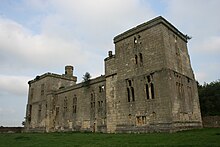Wressle Castle
Wressle Castle is a ruined palace-fortress in the East Riding of Yorkshire, England, built for Thomas Percy in the 1390s.
[2][3] Wressle Castle originally consisted of four ranges built around a central courtyard; there was a tower at each corner, and the structure was entered through a gatehouse in the east wall, facing the village.
After Thomas Percy was executed for rebelling against Henry IV, Wressle Castle was confiscated by the Crown.
[4] With occasional periods when it was granted to other people, the castle was mostly under royal control until 1471 when it was returned to the Percy family.
Henry Percy, 5th Earl of Northumberland, refurbished the castle and gardens, bringing them to the standard of royal properties.
However, it was held by Parliament during the English Civil War and partly demolished in 1646–50, leaving the south range still standing.
According to archaeologist and architectural historian Anthony Emery Wressle Castle was built “as a residence reflecting [the Earl’s] pedigree and distinguished state service”.
[7] Though Henry IV gave Thomas Percy influence in south Wales, relations between the two deteriorated due partly to delays in payment.
Two days later, on 23 July, he was beheaded and his property – including Wressle Castle – was subsequently confiscated by the crown.
[10] The Pilgrimage of Grace was a popular revolt against the rule of Henry VIII in 1536 partly in response to the dissolution of the monasteries.
Aske travelled to Wressle Castle and tried to persuade Henry Algernon Percy, who at the time was suffering from illness, to join the rebellion.
The 1648 demolition work was focused on the castle's battlements,[16] with a contemporary letter noting that “[Parliament’s] agents would show no care in preserving any of the materials, but pitched of[f] the stones from the battlements to the ground”[17] Destruction was more extensive two years later, when Algernon Percy, 10th Earl of Northumberland, was ordered to demolish everything that remain except the south range of the castle.
[23] The state of the site deteriorated to the point at which in 1999 Wressle Castle was included on the Heritage at Risk Register.
[31] This coincides with the career of John Lewyn, who designed the great tower at Warkworth Castle and worked at Lumley, both Percy properties.
The Old Garden contained an orchard and alleys for bowling and walking, popular pastimes of the nobility from the 16th century onwards.
A base court (an enclosed area) was added in front of the castle's gatehouse after the main complex was built, but it unclear when.
Wetland areas south and east of the castle may have been used to emulate a mere, a type of broad shallow lake.




